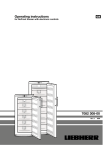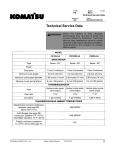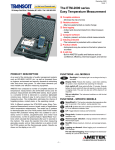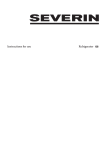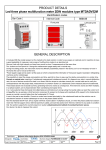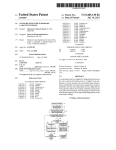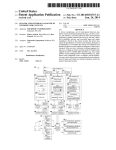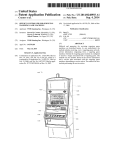Download Liebherr KGT 3046 Premium
Transcript
Operating instructions
for combined refrigerator-freezers
English
Operating instructions
for combined refrigerator-freezers
with electronic controls
7081 432-02
KGT...6
!
Recycled paper
!
700
Pages
14 - 25
The appliance at a glance - instructions in brief
Operating and control elements, fig. A1
Child-proof lock
Freezer
Prevents the appliance from being switched off
accidentally.
6
1 Temperature display and setting display
2 Temperature buttons: top button = higher,
bottom button = lower
3 On/off button
4 Superfrost button
W Hold down the audible warning on/off button and
then press the Superfrost button and keep both
buttons pressed for about 3 seconds. A short
double beep will sound and the display 6 will
light up; the child-proof lock is now active.
- To switch off: press this key combination again;
the display will go off.
with LED showing active function
5 Audible warning on/off button
C OO L ER
SU PE R C O O L
5
O N/ O FF
FRE EZ E R
°C
18
O N/ O FF
SU PE R FRO S T
A LARM
°C
Supercooling
Refrigerator
6 Child-proof lock (refrigerator and freezer display)
7 Temperature display and setting display
8 Temperature buttons: top button = higher,
For fast cooling of food in refrigerator:
W Press the Supercooling button bl briefly so that
the LED comes on: the function is now switched
on.
- Switches off automatically after approx. 6 hours.
bottom button = lower
Superfrost
9 On/off button
bl Supercooling button
For fast freezing of fresh food:
W Press the Superfrost button 4 briefly so that the
LED comes on.
W The freezer will take approx. 6 - 24 hours to
reach its lowest temperature.
W Place the fresh food in the top drawers.
with LED showing active function
A1
Description of appliance and
equipment
fig. A
- The Superfrost function is switched off as
required. The freezer will switch back automatically to normal operation.
Refrigerator, approx. 5°C
Transport grips
Operating and control elements
Butter and cheese compartment
Egg tray*
Interior light
Adjustable bottle holder*
Adjustable pull-out shelves*
Defrost drain (refrigerator)
Adjustable door racks
/"frost-control" display
This means that the freezing temperature has risen
too high during the last few hours or days due to a
power failure. Check the quality of the food.
Information system*
The symbols have the following signification:
Symbol
Type/Data plate
soup, pre-cooked meals
ice-cream
cheese
bread
Vegetable, salad and fruit bins
Door rack for large bottles and drinks
vegetables
fruit
sausages
Freezer, approx. -18°C
A2
Freezer tray*, cold-storage accumulator*
fish
poultry
pork
Drawers with information system* showing drawer
contents, storage time and month of consumption
game
beef/veal
Ice-cube tray/bottle*
A3
A4
A
Name
mushrooms
Defrost drain (freezer)
Adjustable-height feet, transport grips, transport
castors at back
Set the information system on the drawer to the
type of food and month of consumption.
* Depending on model and options
14
Congratulations on your purchase. In choosing this appliance you have opted for all the benefits of
state-of-the-art refrigeration technology, guaranteeing you top quality, a long life span and excellent
reliability.
The features on your appliance have been designed to ensure maximum convenience - day in, day
out.
This appliance has been manufactured with recyclable materials using an environmentally friendly
process, so together you and we are making an active contribution to the preservation of our
environment.
To get to know all the benefits of your new appliance, please read the information contained in
these operating instructions carefully.
We wish you much pleasure with your new appliance.
Additional benefits
Before reading, please fold out and
refer to the illustrated front page.
V CFC- and HFC-free
Keep these operating instructions
in a safe place and pass them on
to the next owner, where applicable.
V Easy to use - intelligent electronic controls
V Temperature controlled within the
temperature range regardless of the
ambient temperature
V Two optimised refrigerant circuits
V Refrigerator and freezer can be
adjusted separately
V Efficient insulation
V Low energy consumption
V Integrated transport grips
V Transport castors at back
V Door handle with integrated
opening mechanism
V Big net refrigerator capacity
V Big net freezer capacity
V Variable, practical features
V Freezer temperature increase alarm
V Power failure/"frost-control" display
V Fresh food can be fast-frozen as required
V All drawers suitable for fast freezing
V Automatic defrosting in refrigerator
V Defrost drain device in freezer
V Easy to clean
V Door hinges can be changed over
V Decor frames available*
Contents
Operating instructions
Page
The appliance at a glance - instructions in brief .. 14
Additional benefits, contents ............................ 15
1 Safety instructions and warnings ...................... 16
Disposal notes ................................................... 16
Setting up .......................................................... 16
Connecting to the mains ................................... 16
2 Operation and control elements ........................ 17
Switching the appliance on and off ................... 17
Setting the temperature .................................... 17
Child-proof lock ................................................. 17
Temperature display .......................................... 17
Audible warning signal ...................................... 18
Power failure/"frost-control" display ................. 18
Supercooling ..................................................... 18
3 Refrigerator compartment ................................. 19
Arranging food in the refrigerator ...................... 19
Changing shelf arrangement ............................. 19
Interior light ........................................................ 19
4 Freezer compartment ........................................ 20
Superfrost .......................................................... 20
Notes on freezing and storage .......................... 20
Information system ............................................ 21
Freezer tray ........................................................ 21
Cold-storage accumulators ............................... 21
Making ice-cubes .............................................. 21
5 Defrosting .......................................................... 22
Cleaning ............................................................. 22
Energy savings .................................................. 22
6 Malfunctions ...................................................... 23
Customer service and type plate ...................... 23
Instructions for installation and modification
Safety regulations .............................................. 24
Dimensions ........................................................ 24
Changing over door hinges ............................... 24
Insertion into row of kitchen units ..................... 25
Notes on assembling decor panels* ................. 25
15
1 Safety instructions and warnings
The packaging is designed to protect the appliance and individual components during transport
and is made of recyclable materials.
- Corrugated board/board
- Moulded polystyrene (foamed, CFC-free
polystyrene)
- Polythene bags and sheets
- Polypropylene straps
W Keep packaging materials away from children polythene sheets and bags can suffocate!
W Please return the packaging material to your
nearest official collection point so that the various
materials can be reused or recycled as far as
possible.
Your old appliance:
This contains some reusable materials and should
not simply be disposed of with household or bulk
refuse.
W Disable discarded appliances immediately by
removing the plug and cutting through the
connection cable.
Remove the spring-action or bolt catch from
the appliance or render it unusable so that
children cannot become trapped inside and
suffocate.
W Ensure that the refrigerant circuit is not damaged
before the appliance that is no longer needed is
taken away for disposal. In this way the refrigerant or oil will not escape into the environment.
- Exact details of the refrigerant used can be found
on the type plate. The heat insulator is PU with
Pentane.
- Information on collection dates or collection
points can be obtained from the waste disposal
authorities or local council.
Technical safety
W To prevent injury or damage to the unit, the
appliance should only be transported wrapped
and set up by two people.
W The refrigerant R 600a is environmentally friendly
but flammable.
W Do not damage the refrigerant circuit pipes.
Splashes of refrigerant can harm your eyes or ignite.
W If refrigerant escapes, remove all naked flames or
sources of ignition in the vicinity of the leak,
disconnect the appliance from the mains and
ventilate the area well.
W In the event that the appliance is damaged,
contact the supplier immediately before connecting to the mains.
W To guarantee safe operation, ensure that the
appliance is set up and connected as described
in these operating instructions.
W Disconnect the appliance from the mains if any
fault occurs. Pull out the plug (not by pulling on
the mains cable) or switch off or remove the fuse.
W Any repairs and work on the appliance should
only be carried out by the customer service
department, as unauthorised work could prove
highly dangerous for the user. The same applies
to changing the mains power cable.
Safety during use
W Do not store explosives or sprays using combustible
propellants such as butane, propane, pentane, etc.
in the appliance. Electrical components might
cause leaking gas to ignite. You can identify such
sprays by the printed contents or a flame symbol.
W Only store high-percentage alcohol in tightly
sealed, upright containers.
W Do not allow naked flames or ignition sources to
enter the appliance.
W Do not use electrical appliances inside the appliance
(e.g. steam cleaners, heaters, ice makers, etc.).
W Do not stand on the plinth, drawers or doors or
use them to support anything else.
16
W Do not let children play with the appliance, e.g.
do not allow them to sit in the drawers or swing
on the door.
W Do not eat ice-cream, particularly ice lollies or
ice-cubes, immediately after taking them from
the freezer compartment as there is a risk of
"burning" because of the very cold temperatures.
W Do not consume food which has been stored for
too long, as it could cause food poisoning.
Setting up
W When setting up/fitting ensure that the refrigerant
circuit pipes are not damaged.
W Screw the handles* onto the doors using the holes
provided.
By fitting* these parts yourself you will help to save
on packaging material.
W Once in position, use the 10 spanner provided to
adjust the feet so that the appliance is level and
does not wobble.
W Avoid positioning in direct sunlight or next to an
oven, radiator or similar, in damp locations or
near spraying water.
W The ventilation grilles should not be ob-structed. Always ensure that there is good ventilation and that the outward flowing air is able to
escape.
W More information can be found in the installation
and modification instructions.
W Do not place heat-emitting appliances, e.g.
microwave oven, toaster, etc., on top of the refrigerator or freezer.
W Remove the transport attachments on the
shelves and insert at the desired height.
2 Operation and control elements
You are advised to clean the appliance before
switching it on for the first time (see "Cleaning").
Switch on the appliance approx. 2 hours before
loading it with frozen food for the first time. Do not
load with frozen food until the temperature shows
at least -18°C. The
refrigerator and
freezer compartments can be operated separately.
Switching the appliance on and
off
fig. A1
W Switching on: Press the on/off buttons (9 on
left for refrigerator, 3 on right for freezer) so
that the temperature displays light up or flash.
- Refrigerator: The interior light will light up when
the door is open.
- Freezer: The alarm will sound when the appliance is switched on for the first time and when
the appliance is "warm".
Press the alarm off button 5 to switch it off.
See the "Audible warning signal" for more information.
W Switching off: Press the on/off buttons again so
that the temperature displays go out.
Setting the temperature
fig. A1
The appliance is pre-set for normal operation. We
recommend temperatures of +5°C in the refrigerator and -18°C in the freezer.
W To reduce the temperature:
Press the bottom button; 8 on left for refrigerator and 2 on right for freezer.
W To increase the temperature:
Press the top button.
- While you are entering the temperature, the set
temperature will flash on the display.
- When you press the temperature setting buttons
for the first time, the most recent setting (known
as the "reference setting") is displayed.
- You can change the settings in increments of
1°C by briefly pressing the buttons again. If the
buttons are held down the temperature setting
will change faster.
- Approximately 5 seconds after the button has
been released, the display will automatically
show the actual freezing or cooling temperature
(known as the "actual setting").
- You can change the temperatures
in the refrigerator: between 11° and 2°C and
in the freezer:
between -14° and -28°C.
Whether you can obtain the lowest temperature
depends on where the appliance is positioned (if
it is located in an area with a high ambient temperature it will not reach the lowest temperature).
Child-proof lock
fig. A1
The child-proof lock is designed to protect the appliance from being switched off accidentally.
W Switching on the child-proof lock: Hold down
the audible warning on/off button 5 and then
press the Superfrost button 4, and keep both
buttons pressed simultaneously for approx. 3
seconds.
- A double beep confirms your entry.
- The LED 6 will come on.
W Switching off: Press this key combination again;
the LED 6 will now go out.
Temperature display
fig. A1
In normal operation, the following settings will be
displayed:
- the average refrigerator temperature in
display 7 and
- the warmest frozen food temperature in
display 1.
When starting up for the first time or when the
appliance is warm, dashes will appear until the
temperature reaches a level that can be displayed
(19° to 0°C in the refrigerator and below 0°C in the
freezer).
The display will flash:
- if you change the temperature or
- if the temperature rises by several degrees,
indicating cold loss, e.g. if you place fresh,
"warm" food in the freezer or if you remove or repack frozen food the temperature may rise for a
short time due to warm air flowing into the freezer. Once you have finished loading or re-packing, the electronics will automatically re-set the
temperature to the most recent setting. Shortterm rises in temperature will not affect the
frozen food.
W If "F 1" to "F 5" appears in the display, the appliance has a fault. Consult the customer service department indicating the fault number displayed as this will tell the technician what kind of
irregularity has occurred.
Display brightness
Your appliance is delivered with the display brightness set to low.
When the door is opened or the temperature settings changed, the display automatically switches
to bright for one minute, or as long as
the alarm state lasts.
You can change the brightness if required, fig. A1:
W To make display brighter: Keep the audible
warning on/off button pressed and press button
2 (increase temperature in freezer) simultaneously.
W To make display darker: Keep the audible
warning on/off button pressed and press button
2 (reduce temperature in freezer) simultaneously.
17
2 Operation and control elements
Audible warning signal
Supercooling
fig. A1
The audible warning signal helps to protect frozen
food and to save energy.
fig. A1
The Supercooling button switches the refrigerator
compartment to maximum cooling.
It is recommended particularly if you wish to cool
large quantities of food, drinks, freshly baked cakes
or meals rapidly.
W Switching on Supercooling: Press the Supercooling button bl briefly so that the LED comes
on.
- The refrigerator temperature will drop to its
lowest value (dependent on the room temperature).
W The audible warning device is switched off by
pressing the audible warning on/off button 5.
- It switches off automatically as soon as the
temperature is low enough.
- It always sounds if the freezer temperature is not
low enough (dependent on the temperature
setting).
- The temperature display flashes at the same
time.
This can be caused by:
- warm, fresh food being placed in the freezer,
- too much warm air from the outside entering
when re-arranging or removing frozen food.
The temperature display will continue to flash until
the cause of the alarm has been rectified. It will
then stop flashing and light up continually. The
audible warning signal is now automatically reset.
Power failure/"frost-control"
display
fig. A1
If
appears in the display, this means that the
freezer temperature has risen too high during the
last few hours or days due to a power failure.
Once the power is re-instated, the appliance will
continue to operate at the most recent temperature setting.
W If you press the audible warning on/off button 5
whilst the display is reading , the highest
temperature registered during the power failure
will be displayed.
Check the quality of the food and its suitability
for consumption in case it has become too warm
or even defrosted.
The highest temperature will appear for approx.
1 minute. After that, the actual temperature in
the freezer will re-appear. The display can be
switched off by repeatedly pressing the audible
warning on/off button.
18
Note:
The Supercooling function uses slightly more
energy. After approx. 6 hours, however, the
refrigerator switches back automatically to
normal energy-saving operation.
If required, the Supercooling function can be
switched off sooner.
W Switching off: Press the Supercooling button
again so that the LED goes out.
3 Refrigerator compartment
Arranging food in the refrigerator
4
1
5
2
6
Because of the natural circulation of air in the refrigerator
compartment, the temperature in different parts of the
refrigerator will differ, each area being suitable for different
types of food. The refrigerator is coldest just above the
vegetable bins and against the rear wall (suitable for
sausage and meat products etc.); it is warmest at the front
at the top and in the door (suitable for spreadable butter,
cheese etc.). See fig. B for food storage suggestions.
3
7
fig. B
1 butter, cheese
2 eggs
3 cans, drinks, bottles
4 preserves, baked goods, pre-cooked meals
5 dairy products
6 meat and sausage products, fish
7 fruit, vegetables, salad
fig. C
fig. D1
fig. D2
Notes on cooling
- Store food so that air can circulate properly around it.
Do not pack the refrigerator too full.
- Food which gives off or absorbs odours and flavours,
and liquids should always be stored covered or in
closed containers. High-percentage alcoholic drinks
should be tightly sealed and stored upright.
Changing shelf arrangement
You can re-arrange the height of the shelves and door
racks as required.
W Re-positioning the door racks, fig. C: Slide the door
rack up, pull out towards you and replace in reverse
order.
W By adjusting the bottle holder you can protect the
bottles from falling over when the door is opened and
closed.
W Shelves* (grids or glass shelves) can be adjusted in
height for different height items, fig. D1:
- Slide the shelf forwards, lift and remove. Always insert
shelves with the raised edge at the back pointing
upwards, otherwise food may freeze onto the rear wall.
- The glass shelves can be pulled out a certain distance,
fig. D2. This enables you to reach and remove items at
the back of the shelves more easily.
W If you require space for large bottles and containers,
- slide one half of the glass shelf* to the back, fig. E1, or
- lift up the flap* in the grid shelf, fig. E2.
W You can use the bottle basket*, fig. E3, to chill drinks
and carry several bottles at once.
Interior light
fig. E1
fig. E2
fig. E3
1
2
1
fig. F1
fig. F2
This switches off automatically after the door has been
opened for approx. 15 minutes. If it does not switch on
when the door is opened briefly, but the temperature
display is working, the bulb may be defective.
Replacing the bulb:
W Bulb data: max. 25 W; current and voltage must agree
with the details on the type plate. Bulb fitting: E 14.
W Switch off the appliance. Disconnect from the mains
or remove or unscrew the fuse.
W Press the light cover together at the sides as in fig. F1
(1). Lift it out and unclip at back (2).
W Replace the bulb as in fig. F2. To counteract the friction
seal, turn with slightly more pressure. When inserting,
make sure that the seal is properly in place in the lamp
socket.
W Clip the back end of the cover in and clip the sides into
place.
* Depending on model and options
19
4 Freezer compartment
Superfrost
Fresh food should be frozen to the core as rapidly
as possible. Frozen food can also be given a cold
boost. This is provided by the "Superfrost" facility
and ensures that the nutritional value, appearance
and flavour of the food remain intact.
W The maximum amount of food which can be
frozen in 24 hours is shown on the type plate
("Freezing capacity ... kg/24h"), fig. A2, pos. 4.
This amount varies according to the model and
climate rating.
Freezing with Superfrost
W Press the Superfrost button 4 briefly so that the
LED lights up.
The freezer temperature will decrease and the
appliance will switch to the lowest temperature.
W For small amounts of frozen food, it is normally
sufficient to switch on Superfrost 6 hours beforehand. For the maximum amount (see freezing
capacity on the type plate) you will need to
switch it on 24 hours beforehand.
W Then place the fresh food inside the freezer,
preferably in the top drawers.
If freezing the maximum quantity of food, do not
use the drawers; instead, place the wrapped
food directly on the cooling plates. Once the
food is frozen you can load it into the drawers.
- The Superfrost function switches off automatically. Depending on the quantity of food placed
in the freezer, this will normally be between 30
and max. 60 hours. The freezing process is now
complete, the Superfrost LED will go out, and
the freezer will switch back to normal energysaving operation.
Note:
You should not switch on the Superfrost function:
- when placing frozen food in the freezer;
- when freezing up to approx. 2 kg fresh food
daily.
Notes on freezing and storage
W Items suitable for freezing: meat, game,
poultry, fresh fish, vegetables, fruit, dairy products, bread, baked goods, pre-cooked meals.
Not suitable: lettuce, radishes, grapes, whole
apples and pears, fatty meat.
W Pack frozen food in standard freezer bags or reusable plastic, metal or aluminium containers.
W Do not allow fresh food which is to be frozen to
come into contact with food already frozen.
Always keep packs dry in order to avoid them
sticking together.
W Always write the date and contents on the pack
and do not exceed the stated storage time for the
food. This prevents any risk of quality impairment.
20
W Pack food which you are freezing yourself in
quantities appropriate to your household. To
ensure that the food freezes right through
quickly, the following quantities should not be
exceeded per package:
- fruit, vegetables: up to 1 kg;
- meat: up to 2.5 kg.
W Blanch vegetables after washing and cutting
them. (Add to boiling water for 2-3 minutes,
remove and quickly cool down in cold water. If
you blanch with a steamer or microwave oven,
please observe the relevant operating instructions.)
W Do not salt or season fresh food or blanched
vegetables before freezing. Only lightly salt and
season other food. Some spices can alter their
flavour intensity.
W Do not freeze bottles and cans which contain
carbonated drinks as they might burst. Drinks
can be cooled down quickly, but take the bottles
out of the freezer compartment after an hour at
the most.
W Storage: Each drawer and
cooling plate can take up to
25 kg frozen food.
W Removing drawers: Pull
forward until the drawer
stops and lift out.
If the drawers are removed,
the cooling plates must not
be loaded above the loading
limit (arrows on the side
walls) at the front, fig. 1.
W Always store identical food items together to
avoid the door being open for unnec-essarily
long periods and to save energy.
W Do not exceed storage times given.
W Thawing: Only take out as much food as is
immediately required for thawing. Cook food
which has been thawed as quickly as possible.
Frozen food can be thawed in the following
ways:
- in a conventional or fan oven
- in a microwave oven
- at room temperature
- in the refrigerator: the cold given off by the
frozen food is used for cooling the other food.
- Flat portions of meat or fish can be cooked when
partially thawed.
- Vegetables can be cooked from frozen (in half
the normal time).
W For more details on thawing and storage times,
consult a specialist book on freezing.
4 Freezer compartment
The information system*
Helps you keep track of what you have stored in the freezer.
It shows you at a glance what has to be used and when. It
tells you what food you have in the freezer 1, the number of
months it can be stored 2 and the month by which it should
be consumed 3.
Storage times given are guide times for food frozen at home.
Whether or not the lower or upper value is applicable depends on the food quality and how it was processed prior to
freezing. The lower values always apply to food with a high
fat content. You can calculate the month by which the food
should be consumed by adding the storage time to the
month of freezing. For ready-frozen food, check the use-by
date on the packaging.
Fig. G:
W Position a slide against the symbol for the frozen food
you are storing and position the slide of the same colour
against the month by which the food should be consumed.
- Example: For fish that can be kept until March, position
one slide against the symbol for fish and the slide of the
same colour against the month number 3 for March.
fig. G
The freezer tray*
This is used for gently freezing berries, herbs, vegetables
and other small items and prevents them from sticking
together. Items being frozen will largely retain their shape,
and it will be easier to remove exactly the right quantity
later on.
W Spread the items out loosely on the tray, fig. H.
W Suspend the freezer tray in one of the top drawers.
Freeze for 10 to 12 hours, then transfer to a freezer bag
or container and put in a drawer.
W To defrost, spread the frozen items out loosely.
fig. H
Cold-storage accumulators*
These prevent the temperature in the freezer from rising
too quickly in the event of a power failure, thus preserving
the quality of the food.
W To save space, you can freeze and store the coldstorage accumulators in the freezer tray, fig. J.
- To ensure maximum storage time in the event of a
power failure, place the frozen cold-storage accumulators in the top freezer drawer on top of the food.
Making ice-cubes
fig. J
ma x
fig. K1
.
fig. K2
Fill the ice-cube bottle* up to the mark with water, fig. K1,
and seal with the lid 1. Distribute the water evenly amongst
the cells in the ice-cube bottle by holding the bottle horizontally and shaking gently from side to side, and freeze.
To remove the ice-cubes, hold the ice-cube side of the
bottle under running water for a short time. The ice-cubes
can then be shaken out through the bottle opening. The
ice-cube bottle can be separated into an upper 2 and
lower 3 section for cleaning.
Fill the ice-cube tray* three-quarters full with water and
freeze, fig. K2. The ice-cubes can be removed from the
tray by twisting or by holding upside down for a short time
under running water.
* Depending on model and options
21
5 Defrosting, cleaning, energy savings
Defrosting
The refrigerator compartment
defrosts automatically. The defrost water is evaporated by the heat from the compressor; drops of
water on the rear wall are perfectly normal.
W Ensure that the defrost water can flow freely
through the drain hole in the rear wall (arrow in
fig. A).
The freezer compartment
After the appliance has been in operation for some
time, a layer of ice will form on the aluminium
panels and the fronts of the drawers if the door is
opened and fresh food placed inside the freezer
regularly. This is completely normal.
However, a thick layer of ice will increase the
appliance's energy consumption. You should
therefore defrost the appliance regularly:
W Switch on "Superfrost" the day before defrosting
to give the food a cold boost.
W To defrost, disconnect the appliance from the
mains or press the freezer on/off button so that
the temperature display goes out. If the display
does not go out, the child-proof lock is activated.
W If possible, put the frozen goods in the freezer
drawer with the cold-storage accumulators on
top, wrap in newspaper or a blanket and store in
a cool place.
W Pull out the defrost drain pipe 1 (fig. A3) and
place a bowl or the empty bottom freezer drawer
underneath. If you use the bottom drawer 2,
push the drain pipe through the slot in the end
(fig. A4).
W To speed up the defrosting process put a saucepan of hot but not boiling water on one of the
shelves.
Do not use electric heaters or steam cleaners,
defrosting sprays or naked flames for defrosting nor any metal objects for removing
the ice. Risk of injury and damage!
W Leave the door of the appliance open while defrosting.
After defrosting, mop up the remaining water and
clean the appliance.
Cleaning
W Before cleaning, always switch off the appliance. Disconnect from the mains or unscrew or remove the fuse.
W Clean the outer walls, inside and equipment by
hand with lukewarm water and a little detergent.
Because of the risk of injury and damage to the
appliance, steam cleaning equipment should not
be used.
Never use abrasive or scouring sponges. Do not
use concentrated cleaning agents and never use
abrasive or acid cleaners or chemical solvents.
- We recommend using a soft cloth and an allpurpose cleaner with a neutral pH value.
- We recommend treating stainless steel appliances* with a special stainless steel cleaning
agent after normal cleaning.
- Do not allow cleaning water to run down the
22
drain gulley or to penetrate the ventilation grilles
or electrical components. Dry the appliance.
- Do not damage or remove the type plate on the
inside of the appliance. It is very important for
servicing purposes.
W The butter dish can be washed in a dishwasher.
The racks, shelves and other components should
be cleaned by hand as they are not dishwashersafe.
W Clean the drain hole on the rear wall above the
vegetable bins frequently, fig. A, arrow.
If necessary, clean with a thin object, e.g. a
cotton swab or similar.
W The dust should be removed from
the refrigeration unit and heat
exchanger - metal grid at the back
of the appliance - once a year.
Dust deposits increase energy
consumption.
W Ensure that none of the wires or
other components are dislodged, bent or damaged.
W Then connect/switch on the appliance and start
to insert the food to be frozen as the temperature
drops.
If the appliance is to be left switched off for any
length of time, empty the appliance, disconnect
from the mains, clean as described above and
leave the door open so as to avoid odours.
Notes on energy saving
W Ensure that there is adequate space around the
appliance for ventilation and air extraction.
W Avoid keeping the door open for too long.
W Store food logically. Do not exceed the storage
period specified.
W Keep all food properly packed and covered so as
to avoid its frosting up on the outside.
W Always allow hot food to cool to room temperature before placing in the appliance.
W Defrost frozen food in the refrigerator.
W If an ice layer forms in the freezer, defrost it. This
will improve the cold transfer and reduce energy
consumption.
W Keep the appliance door shut in the event of a
breakdown. This will delay the cold loss and will
help to maintain the quality of the frozen food for
longer.
6 Malfunctions
Your appliance is designed and manufactured for a long
life span and reliable operation.
If a malfunction nonetheless occurs during operation,
check whether it is due to an operating error. Please note
that even during the warranty period the resultant servicing
costs in this case will have to be borne by the owner.
You may be able to rectify the following faults by checking
the possible causes yourself:
Malfunction
Possible cause and remedy
Appliance does not - Is the appliance switched on
work, display is off
properly?
- Is the mains plug properly inserted
in the socket?
- Is the socket fuse intact?
Customer service and type plate
If none of the above causes apply and you cannot
rectify the fault yourself, or if the temperature display
reads "F 1 " to " F 5", this means that there is a
fault. Please contact your nearest customer service
department (see enclosed list for addresses). Give
the fault number displayed, together with the
type designation 1,
service number 2 and
appliance number 3
as given on the type plate, fig. A2, so as to ensure
rapid, accurate servicing. The type plate is located
inside the appliance on the left-hand side.
The interior light
- Is the refrigerator compartment
does not come on
switched on?
- Has the door been open for more
than 15 minutes?
- The bulb is defective. Change the
bulb as described in "Interior light".
Loud running noise - Is the appliance standing firmly on
the floor, or does the compressor
cause nearby items of furniture or
objects to vibrate?
If necessary, move the appliance
slightly, align by adjusting the
adjustable feet, or move bottles
and containers apart.
- Burbling noises are normal. These
are caused by the refrigerant
flowing round the refrigerant circuit.
A short clicking sound: This will be
heard whenever the refrigeration
unit (the motor) switches on or off
automatically.
Motor noise: This will be slightly
louder for a brief period when the
refrigeration unit switches on.
The alarm sounds, - Is the temperature setting correct?
the temperature is - If necessary, set a lower temperature
and check the display after 24 hours.
not low enough
- Check as described in "Audible
warning signal".
- Loose thermometer in appliance is
showing a wrong reading.
- Is the ventilation system working
properly? Make sure the ventilation
grilles are not blocked.
appears in the - There has been a power failure;
display
proceed as described in "Power
failure/"frost-control" display".
23
Instructions for installation and modification
Before reading, please fold out the
illustrated back page.
Safety regulations
W The appliance is designed to cool, freeze and store
food and to make ice. It is designed as a household
appliance. If used commercially, the relevant regulations on commercial use must be observed.
W The appliance is set to operate within specific ambient
temperature limits according to its climate rating.
These temperature limits should not be exceeded. The
correct climate rating for your appliance is indicated on
the type plate. This is explained as follows:
Climate rating
Set for ambient temperatures of
SN
N
ST
T
+10°C to
+16°C to
+18°C to
+18°C to
+32°C
+32°C
+38°C
+43°C
- The refrigerant circuit has been tested for leaks.
- The appliance complies with current safety regulations
and EC directives 73/23/EEC and 89/336/EEC.
Dimensions
The external dimensions of the appliance can be seen on
the illustration at the back (fig. A) and in the table below.
Gross capacity of appliance (l)
(see type plate)
252
291
339
378
385
(26..)
(30..)
(35..)
(39..)
(40..)
height H
(mm)
1431
1625
1806
2000
1982
Changing over door hinges
fig. B
The door hinges can be changed from one side to the
other if required.
W With the door open, lever out plinth panel 1 with a
screwdriver and remove.
- Lever out cover 2 with a screwdriver.
Close door.
- Unscrew screw M5 3.
W Pull hinge component 4 with hinge pin 5 out from
underneath and remove.
- Open door, lift out at bottom and remove.
- Pull middle hinge pin 6 out from underneath.
- Tilt out top door and lift off from underneath; do not
lose the spacer.
W Transfer all hinge components onto the other side:
- Unscrew top hinge pin 7 and screw in on opposite
side. Use the hexagon socket on the open-ended
spanner provided (spanner width 5).
- Centre: Change over cover 8 with hinge bm: remove
the cover caps 9 with the blade of a knife, unscrew
screws bl, lift off cover 8 and hinge bm to the side, turn
through 180° and replace on the other side, remove
mounting point bn and insert from top.
- Bottom: Using a screwdriver, remove the spacer bo and
replace on the other side.
W Re-attach the doors:
- Remove plugs bp from the door mounting points and
replace on the other side.
- Suspend top door with spacer in hinge pin 7, close
door.
- Slide middle hinge pin 6 into the door mounting from
below through the hinge bm. Make sure the door is flush
with the body of the appliance; adjust if necessary using
the slots on the hinge.
- Suspend lower door, close.
- Rotate hinge component 4 by 180°, remove hinge pin
5 and replace in the reverse order. Mount both parts
in the hinge bq: slide the pin into the door mounting
through the hinge, tilt in the hinge component, slide up
and attach with screw 3.
W Align the door flush with the body of the appliance
using the slot on the hinge bq, then tighten screw 3.
W Attach the plinth panel 1 and click into place by
pressing.
W With the door open, insert the cover 2 in the plinth
panel at the front and click into place at the back.
W Assemble* door handles br and plugs bt: click cover
strip* bs into place. (To remove: prise out the cover
strip in the slot in the handle using a knife blade).
- Remove and re-attach slimline handles* with the 2.5 mm
hexagon key provided as illustrated in fig. B2.
W If your refrigerator has a bottle basket, put the vegetable bin on the other side (the bottle basket should
always be on the same side as the door handle) to
facilitate removal of the basket:
- Remove bottle basket, vegetable bins and glass shelf.
- Move the plastic rail 1 on the glass shelf, fig. B1: turn
the shelf over, lift out the rail at the front by tapping
slightly and remove towards back.
- Replace the rail 1 on the other outside attachment on
the glass shelf, put in position at back and clip into
place at front.
- Remove side component 2 sideways and replace on
the other side. Replace glass shelf, vegetable bins and
bottle basket.
* Depending on model and options
24
Instructions for installation and modification
Insertion into row of kitchen units
Notes on assembling decor panels*
fig. C
The appliance can be installed in any fitted kitchen. To
adapt the height of the appliance to the surrounding
furniture a top unit 1 can be added.
A gap of at least 50 mm depth must be provided behind
and along the entire width of this unit so as to ensure
sufficient ventilation. The area of ventilation underneath
the ceiling should be at least 300 cm2. The greater the
area the more economically the appliance will run.
W When installing with standard kitchen units (max. depth
580 mm) and decor panels of max. 2 mm thickness, the
appliance can be set up right next to the kitchen unit.
The door protrudes 34 mm from the side of the kitchen
unit and 51 mm at the front. This enables it to be
opened and closed without difficulty.
W When setting up the appliance next to a wall 4, a
minimum distance of 36 mm must be provided on the
hinge side between the appliance and the wall (for the
handle when the door is open).
Decor panel and frames can be attached to the door of
your appliance to match or contrast it to the existing
kitchen colour scheme.
The panels are available from your kitchen furniture
supplier. The frames can be fitted later and are available
from your dealer.
If you wish to fit the decor panels yourself, you will need a
drill or a rechargeable screwdriver to pre-drill the retaining
holes. For further instructions and dimensions see the
installation instructions included in the retrofit kit.
W If you wish to attach the appliance to adjacent units or
to fit a spacer between the appliance and the wall,
please note the following:
- Verify that the door can open and close properly.
- Do not drill holes inside the marked area (fig. C),
otherwise damage could be caused to foamed components. For dimension figure A according to the specific
freezer size see the table below.
Freezer compartment with dimension figure A (mm)
2 drawers
660
3 drawers
4 drawers
850
1040
- Attach appliance to kitchen units with self-tapping
screws (max. depth 10 mm).
1 top unit
2 refrigerator/freezer
3 kitchen unit side panel
4 wall
All types and models are subject to continuous improvement and the manufacturer therefore reserves the right
to make modifications in the shape, equipment and
technology.
* Depending on model and options
25
min.
300 cm2
631
597
614
[mm]
50
n.
mi
1
63
1
633
0
58
2
1177
0
45
A
H
3
4
ca. 36
10
56
,5
2
A
3
C
11 12
6 17 *16 * 14
18 *
1
2
7
SW5
B1
M4
9
14
10
8
16 *
M4
13
16 *
M4
5
2
4
15
3
13
B
SW2,5
16 *
M4
15
1
SW2,5
5
M4
4
B2
18 *















